Which driver has the most Indianapolis 500 wins?
Since its inaugural running in 1911, the Indianapolis 500 has crowned a legendary group of drivers. Here we look at the most successful and remarkable
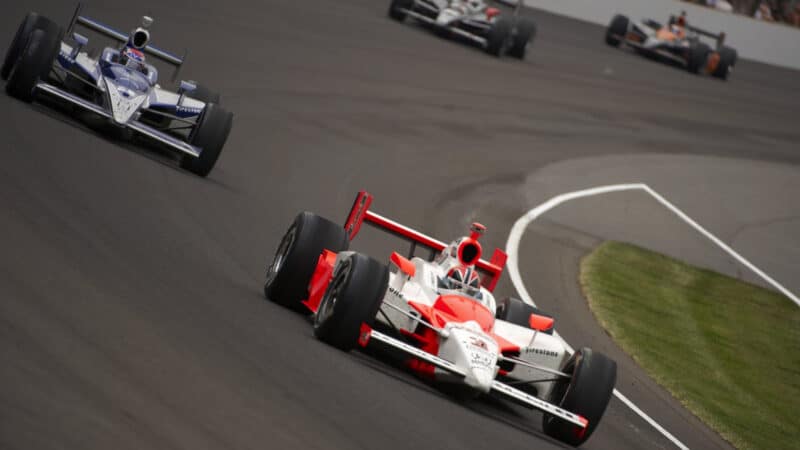
Helio Castroneves will be aiming to become the first five-time winner
Getty Images
For over a century, the Indianapolis 500 has stood as the crown jewel of American motor sport, producing a legendary roster of winners since Ray Harroun’s inaugural triumph in 1911.
The list of Indy 500 winners not only reflects the evolution of racing technology and strategy but also the enduring allure of the ‘Greatest Spectacle in Racing’, drawing champions from around the globe and cementing their names on the iconic Borg-Warner Trophy.
Here we look at the most successful drivers who have helped build the rich history of the iconic race.
| Driver | Years Won |
|---|---|
| A. J. Foyt | 1961, 1964, 1967, 1977 |
| Al Unser | 1970, 1971, 1978, 1987 |
| Rick Mears | 1979, 1984, 1988, 1991 |
| Hélio Castroneves | 2001, 2002, 2009, 2021 |
| Louis Meyer | 1928, 1933, 1936 |
| Wilbur Shaw | 1937, 1939, 1940 |
| Mauri Rose | 1941, 1947, 1948 |
| Bobby Unser | 1968, 1975, 1981 |
| Johnny Rutherford | 1974, 1976, 1980 |
| Dario Franchitti | 2007, 2010, 2012 |
| Tommy Milton | 1921, 1923 |
| Bill Vukovich | 1953, 1954 |
| Rodger Ward | 1959, 1962 |
| Gordon Johncock | 1973, 1982 |
| Emerson Fittipaldi | 1989, 1993 |
| Arie Luyendyk | 1990, 1997 |
| Al Unser Jr. | 1992, 1994 |
| Juan Pablo Montoya | 2000, 2015 |
| Dan Wheldon | 2005, 2011 |
| Takuma Sato | 2017, 2020 |
| Josef Newgarden | 2023, 2024 |
| Jim Clark | 1965 |
| Graham Hill | 1966 |
| Mario Andretti | 1969 |
| Jacques Villeneuve | 1995 |
Four-time winners
A.J. Foyt (1961, 1964, 1967, 1977)
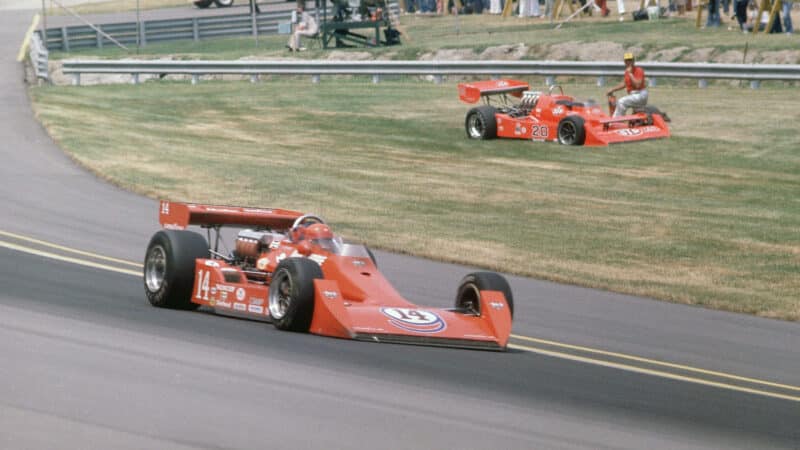
Foyt on his way to an historic fourth victory at the IMS
Getty Images
AJ Foyt became the first driver to win the Indianapolis 500 four times, with victories in 1961, 1964, 1967, and 1977. He’s also the only one to have won the event in both front- and rear-engined cars.
‘Super Tex’s’ first victory came in 1961 in a front-engined Trevis chassis powered by a Offenhauser unit. Foyt was involved in a dramatic battle with Eddie Sachs, and was leading the race after making a stop for fuel late on. However, his fuel rig had malfunctioned and Foyt had to pit again as he wouldn’t have reached the finish. The stop meant giving up the lead and his chances of victory. But, with three laps left, Sachs had to pit as well to change a tyre, allowing Foyt to cruise to victory.
The second of Foyt’s wins came in the tragic 1964 race in which Sachs and Dave MacDonald were killed after a fiery seven-car crash. Foyt took the lead after Parnelli Jones dropped out with mechanical problems and cruised to victory, finishing nearly a lap ahead of the field.
His 1967 victory remains one of the most dramatic in history after long-time leader Jones, driving the STP turbine car, had a mechanical failure with three laps remaining. Foyt inherited the lead but, on the final lap, had a massive scare when a multi-car accident happened right in front of him. He managed to avoid it to win his third Indy 500.
Foyt’s fourth and final win came in 1977, 16 years after his first, in a car constructed in his own name. Foyt had trailed Gordon Johncock for most of the race, but a broken crankshaft handed the lead to the Texan, who went on to score a record-breaking fourth win.
Al Unser Sr. (1970, 1971, 1978, 1987)
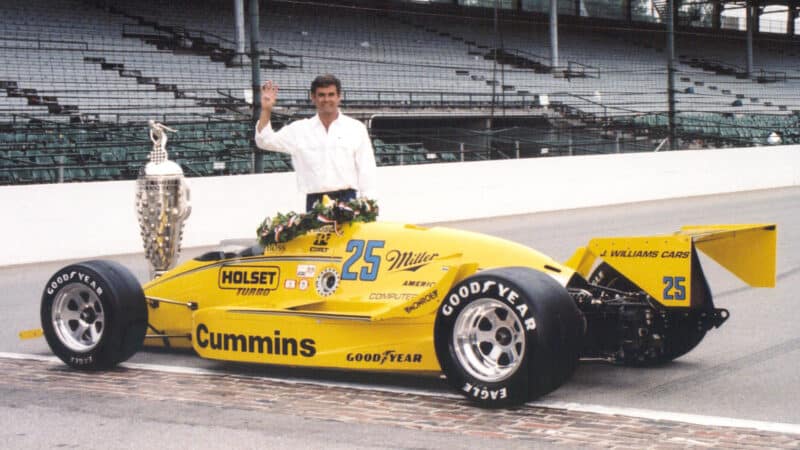
Unser Sr completed his quartet of wins in 1987
IndyCar
Al Unser Sr is not only one of four drivers with four Indy 500 victories, but he’s also one of the few who have won the race back-to-back.
In 1970, Unser dominated the race on his way to his first win, starting from the pole and leading all but 10 of the 200 laps. He finished 32 seconds ahead of runner-up Mark Donohue, marking one of the most commanding wins in Indy 500 history.
The following year, he secured back-to-back victories in a Colt-Ford, again dominating most of the race by leading over 100 laps. That edition was marred by a pace car accident that injured 29 people when it crashed into a photographers’ stand.
The 1978 race offered another display of dominance by Unser, who led a total of 121 laps on his way to achieving the IndyCar’s own ‘Triple Crown’, winning all the 500-mile races (Indianapolis, Pocono, and Ontario) in a single season.
Unser’s final win came in 1987 as an underdog, having qualified down in 20th after a late entry. In a race of attrition, he came through the field and took the lead when Roberto Guerrero stalled in the pits with 17 laps to go, becoming the oldest Indy 500 winner at the time at 48 years of age.
Rick Mears (1979, 1984, 1988, 1991)
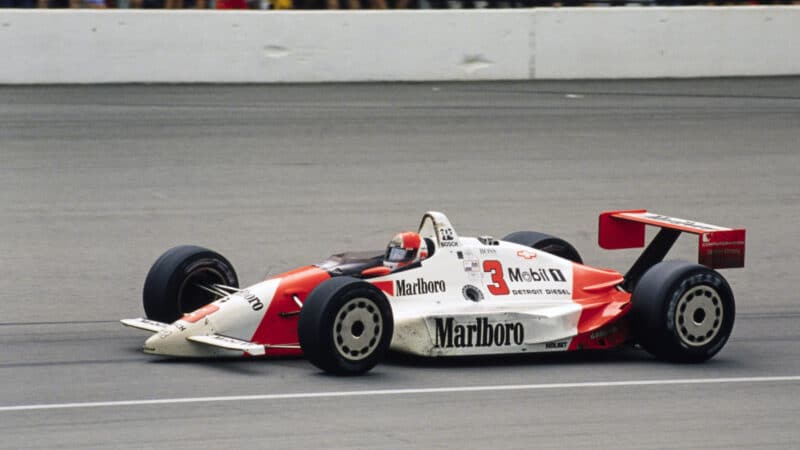
Mears contributed to Penske’s record 20 victories in Indianapolis
Getty Images
Rick Mears is one of the greatest drivers in Indianapolis 500 history with four victories and six pole positions, the latter still being a record.
The Wichita-native only needed two attempts to take his first Indy 500 win in 1979. Having started from the front row, he led for a massive 118 laps, taking the win after several top contenders retired.
In 1984, Mears led for 119 laps from pole position and again capitalised on others’ misfortunes to take a commanding victory, his second for Penske.
Four years later, Mears again started from pole and led for 94 tours, facing strong competition from Emerson Fittipaldi and Al Unser Sr, but maintained control in the closing stages, giving Penske another Indy 500 win.
Mears’ final win at Indianapolis is regarded as one of his most memorable, taking victory after having to qualify with a broken foot following a crash in practice. The race included a remarkable late battle and a pass around the outside of Turn 1 on Michael Andretti with 12 laps to go. It was Mears’ fourth victory with Penske.
Hélio Castroneves (2001, 2002, 2009, 2021)

Can Castroneves add a fifth win this year?
Getty Images
Going into the 2025 race, Castroneves is again the only driver with a chance at making it five wins at the Indianapolis Motor Speedway.
The 50-year-old Brazilian won the race in his first attempt in 2001, leading the final 52 laps to become the second rookie in a row to win after Juan Pablo Montoya’s victory the previous year.
While a rookie victory was not as uncommon, Castroneves achieved a new record the following year by becoming the first driver to win the race in his first two starts. The circumstances of the victory were controversial, however, as Castroneves had been overtaken for the lead by Paul Tracy just as a caution came out. In the end it was ruled that the Brazilian was leading when the caution was triggered, securing victory under the pace car.
It took Castroneves another seven years to return to the winner’s circle, this time starting from pole position and dominating the final part of the race to take his third win in 2009.
In 2021, at the age of 46, Castroneves secured his fourth victory driving for Meyer Shank Racing. In a thrilling late-race battle, he overtook Alex Palou with just two laps to go to secure his fourth crown.
Three-time winners
Louis Meyer (1928, 1933, 1936)
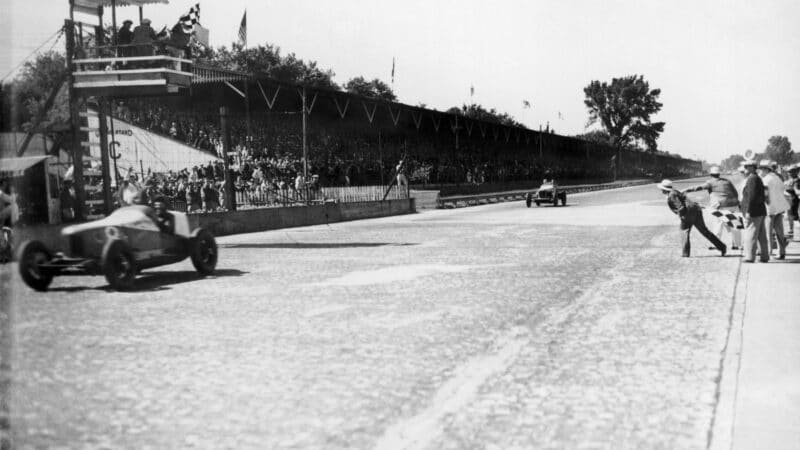
Meyer became the first three-time winner in 1936
Getty Images
In 1928, Louis Meyer joined the growing list of drivers who won the Indy 500 as rookies. Meyer moved up the order after several frontrunners dropped out due to mechanical issues, taking the lead after 400 miles.
Five years later, Meyer secured one of the most dominant victories at the IMS, winning by five laps from Wilbur Shaw. This was the year when the tradition to drink milk after the race started as Meyer drank buttermilk in victory lane.
Meyer became the first three-time Indianapolis 500 winner in 1936, a race where another two traditions were added, as it was the first presentation of the Borg-Warner Trophy and the awarding of the pace car to the winner.
Wilbur Shaw (1937, 1939, 1940)
Shaw finally took his first Indy 500 win in 1937 after several near-misses in previous years, and later became the first man to win the race back-to-back, with consecutive victories in 1939 and 1940, both times driving a Maserati.
Rose won the race in 1941, and it was a peculiar win in that he took the chequered flag in a different car than the one he had started on pole with. His Maserati hit trouble on lap 60 and forced him out, but he then took over the team-mate Floyd Davis’s Wetteroth/Offenhauser. Rose charged from 14th to the lead and to victory, the win shared with Davis.
Rose then took back-to-back wins in 1947 and 1948 driving a Blue Crown Spark Plug Special.
Johnny Rutherford (1974, 1976, 1980)
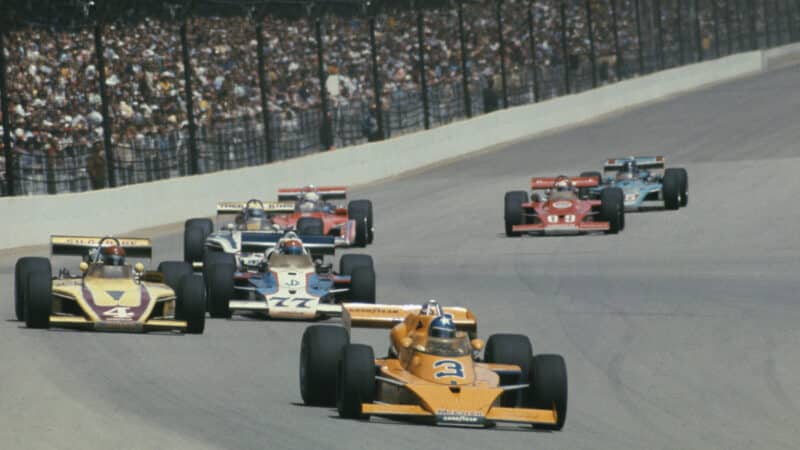
Rutherford leading the pack ahead of his first Indy 500 win in 1974
Getty Images
In his first win in 1974, Rutherford had the lowest-starting position for a race winner since 1936, engine trouble having left him 25th on the grid. But it only took him 65 laps to move into the lead, going on to win by 22 seconds after having led 122 laps.
In contrast to his first victory, his second came from pole position, leading for 48 laps before the race was stopped on lap 102 due to rain. He was declared the winner as the race was not resumed.
Again on pole in 1980, Rutherford took his third win in John Barnard’s ground-effect Chaparral 2K after leading a total of 112 laps.
Bobby Unser (1968, 1975, 1981)
Bobby Unser’s 1968 victory came in dramatic fashion, after leader Joe Leonard’s turbine-powered Lotus 56 hit trouble with eight laps to go. That allowed Unser to cruise to the finish to take victory by nearly a full lap.
His second win, in 1975, came in another shortened race stopped after torrential rain hit the circuit on lap 174.
Unser’s final victory in 1981 remains one of the most controversial in Indianapolis history. He had led for most of the race, but during a caution with 51 laps to go, he overtook several cars while exiting the pits, which was considered a rules infraction. Unser still went on to cross the finish line in first but was penalised a lap, handing victory to Mario Andretti. After months of appeals, the penalty was rescinded and Unser was declared the winner, four months after the race had ended.
Dario Franchitti (2007, 2010, 2012)
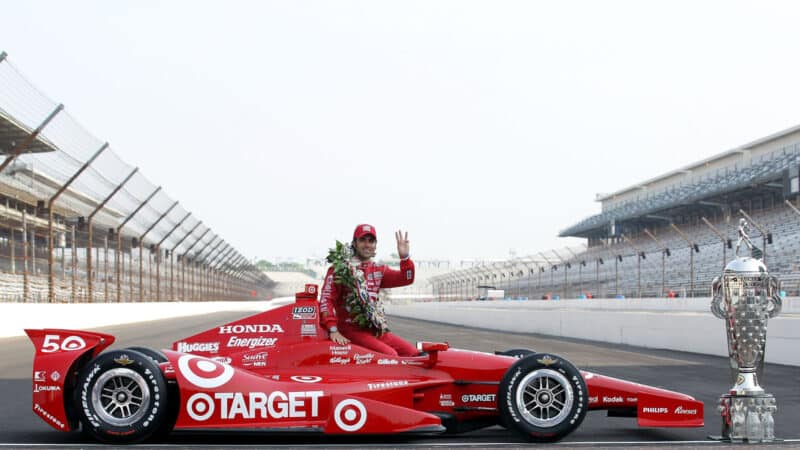
Francchitti celebrated his third victory in 2012
Getty Images
Driving for Andretti Green Racing, Franchitti secured his first Indy 500 win in another rain-shortened race which was called on lap 166, having already suffered a long delay due to poor weather earlier on.
In 2010, Franchitti dominated the event, leading a massive 155 of 200 laps driving for Chip Ganassi. Although the final laps were tense due to fears over fuel mileage, the Scot managed to keep British rival Dan Wheldon behind and secure victory. It was his second win under caution following a late accident.
In a race with 34 lead changes, Franchitti secured his hat trick of wins two years later after a dramatic final lap in which he almost contact with Takuma Sato as the Japanese tried to pass on the inside of Turn 1. Sato crashed, and Franchitti went on to win, once more, under caution.
Two-time winners
Milton was the first two-time winner of the event, the first victory coming in 1921 after having started 20th out of 25 cars. After early leader Ralph De Palma retired with mechanical trouble, the race became a strategic battle between Milton and Roscoe Sarles, the former ultimately taking victory by two laps.
Milton’s second win came after leading all but 21 laps of the 200-lap race, although he was briefly relieved by team-mate Howdy Wilcox in the car while his hands were bandaged due to painful blisters. At the time, relief drivers were allowed but not officially recognised as race winners.
Bill Vukovich, known affectionately as ‘The Mad Russian’, scored back-to-back wins, both coming in dominant fashion. In 1953, he led 195 laps from pole position and refused help from relief drivers, unlike several of his rivals, who were suffering from the extreme heat in what was labelled the ‘Hottest 500’. Vukovich won the race by over three minutes.
The following year Vukovich again dominated, this time leading for 90 laps before winning by a full lap.
Ward was a force to be reckoned with at Indianapolis from 1959 to 1964, finishing in the top four every year and winning twice.
He claimed his first win in 1959 after leading for 130 laps and his second three years later after a close fight with team-mate Len Sutton.
Johncock’s two victories at the IMS came in unique circumstances. The first was in a race delayed several times due to rain and finally took place on the Wednesday of the following week. When the event finally started, it only lasted for 133 laps due to rain. The day was overshadowed by the death of a crew member and the crash of Swede Savage, who died days later in hospital.
Johncock’s second win was a thriller and the closest finish in history at the time, beating Mears by 0.16sec after handling problems allowed the latter to erase an 11-second lead to catch the former, who kept the eventual four-time winner at bay despite several attempts to pass.
Emerson Fittipaldi (1989, 1993)
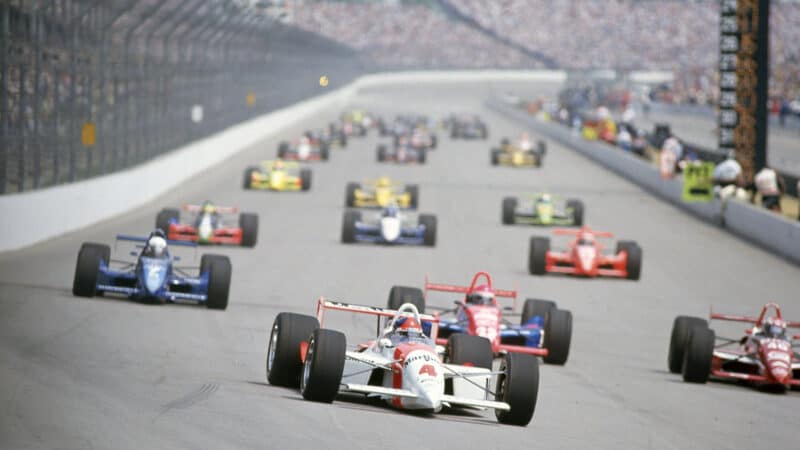
Fittipaldi helped cement Penske’s legendary status at the IMS
Getty Images
Fittipaldi’s first Indy 500 crown in 1989 came after a remarkable fight with Al Unser Jr. The Brazilian had dominated a large part of the race, but had Unser right behind him near the end, the American passing for the lead with a few laps left. As they made their way through traffic, however, they banged wheels as Fittipaldi dove down the inside, sending Unser into the wall and securing victory under yellow.
For his second victory, Fittipaldi paced himself and started to attack towards the end, making a decisive pass on Nigel Mansell with 15 laps left to take the lead and secure the win from the Briton.
Unser’s 1992 victory was one of the closest finishes in history – 0.043sec – after a dramatic battle with Scott Goodyear over the final laps. Despite all his attempts in the last five laps, Goodyear was unable to pass and Unser became the first second-generation winner after his father Al Sr.
After the disappointment of 1993, Unser bounced back as Penske dominated the month and the race in part thanks to a new Mercedes engine capable of nearly 1,000 horsepower.
Luyendyk’s 1990 race, in which he beat Bobby Rahal by 12 seconds in his Doug Shierson Racing entry, stood as the fastest ever for more than 20 years, with an average speed of 185.981mph.
The second victory, in 1997, was achieved with Treadway Racing in more dominant fashion, leading from pole. However, the win was controversial following a confusing final restart, where the white and green flags were displayed while the yellow lights remained on, making several drivers hesitate. Luyendyk didn’t, however, and he managed to get the jump on Goodyear, who could do nothing to stop the Dutchman from winning.
In 2005, Wheldon became the first British driver to win the Indianapolis 500 since Graham Hill in 1966, holding off a charge from Vitor Meira to take the chequered flag. Wheldon not only won the race but also secured the IndyCar title that year.
His 2011 victory remains one of the most remarkable in recent history as he was set to finish second (driving a one-off entry) as he was far from leader and rookie J.R. Hildebrand as the final lap started. But as Hildebrand entered the final turn of the race, he crashed into the wall, allowing Wheldon to sweep past to take an unlikely last-lap win. Despite the crash, Hildebrand finished second in one of the Indy 500’s most incredible finishes.
Juan Pablo Montoya (2000, 2015)

Montoya’s victories came 15 years apart
Getty Images
Driving for Chip Ganassi in 2000, Montoya won his first Indy 500 as a rookie, and he made it look easy too, leading a massive 167 of 200 laps.
Fifteen years after his first win, Montoya captured his second victory, this time with Team Penske, setting a record for the longest gap between wins in race history.
Montoya overtook Will Power with three laps to go and held on for the fourth-closest finish in Indy 500 history, winning by just 0.1046 seconds.
Sato was the first and so far only Japanese (and Asian) driver to win the Indy 500, driving for Andretti Autosport in 2017. He beat Castroneves by just 0.2011 seconds after having taken the lead with five laps remaining.
In 2020, Sato secured his second win after a tense battle with Scott Dixon. The race finished under caution after Spencer Pigot crashed, allowing Sato to cruise to the chequered flag to become the 20th multiple-time winner of the race.
Newgarden is the latest driver to have joined the exclusive club of men with multiple Indianapolis 500 wins, having taken consecutive victories in 2023 and 2024.
His first victory took him 12 attempts and included a dramatic last-lap overtake on Marcus Ericsson, who finished 0.0974sec behind as Newgarden weaved on the start-finish straight to prevent the Swede from having a clear tow. The win ended a long wait for Newgarden and made him the 75th driver to win the Indy 500.
The wait for his second win was very short, however, as a last-lap pass on Pato O’Ward helped Team Penske reach a record 20th Indy 500 victories the following year. This year he attempts to become the first driver in history to take three consecutive Indy 500 wins.
Remarkable one-time winners
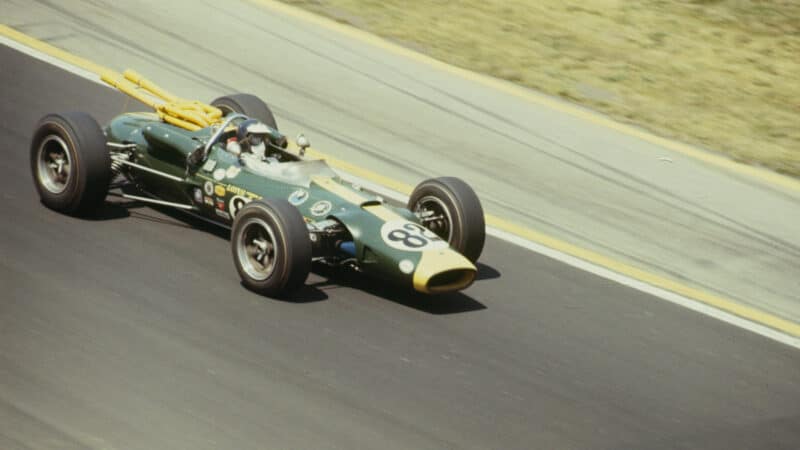
Clark dominated on his way to victory in 1965
Getty Images
Clark won the race in 1965 in dominant fashion, making history as the first driver to take victory in a rear-engined car, the Lotus 38. He led an incredible 190 of 200 laps, his average winning speed the first time the 150-mph barrier was broken. He used a single set of tyres and made only two pitstops on his way to victory, lapping all but four cars.
This win also made Clark the only driver in history to win both the Indianapolis 500 and the Formula 1 title in the same year.
Hill’s 1966 victory was marked by chaos, the former coming after a first-lap accident eliminated 11 cars. Attrition continued to be a factor later on, with only seven cars making it to the finish, the lowest numbers in the race’s history.
Hill survived the chaos and inherited the lead from Jackie Stewart with 11 laps left when the Scot’s car had an oil pressure problem.
Victory made Hill the only driver to have completed the ‘Triple Crown’ – winning the Monaco Grand Prix, the Le Mans 24 Hours and and Indianapolis 500.
Andretti’s sole victory at Indianapolis in his 29 attempts was another remarkable one as he was forced to switch cars after crashing his four-wheel-drive Lotus during practice, an accident that also caused him burns to his face.
As a result of the crash, Andretti had to use a two-year-old backup Brawner Hawk that was not intended to be race. Despite that, he qualified second and was a contender for victory from the start, ultimately going on to led 116 laps despite several scares in the form of mechanical issues.
The win stands as the lone victory at the race for the famous Andretti racing family.
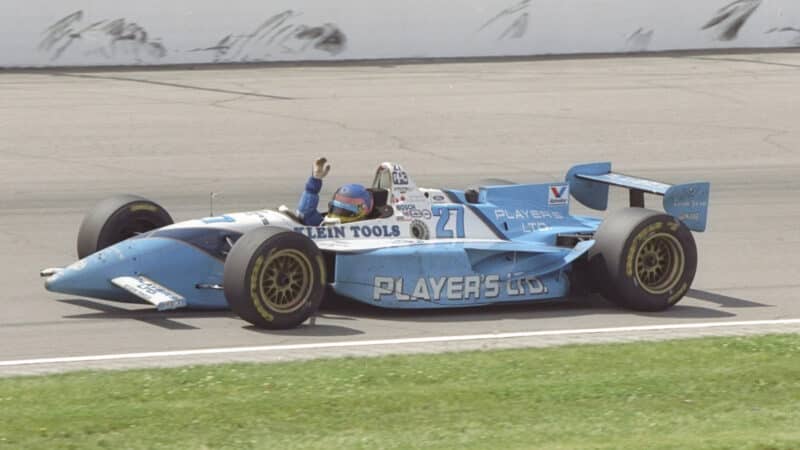
Villeneuve took un unlikely win in 1995
Getty Images
Villeneuve won the Indianapolis 500 in his second attempt, having finished runner-up in his rookie outing the year before.
The Canadian had to make a sensational comeback to secure victory, though, as he was penalised two laps for passing the pace car during a caution period. So he methodically worked his way through the field and, helped by strategy and helpful cautions, returned to the lead lap. His cause was also helped by some of the favourites crashing and having problems.
Leader Scott Goodyear looked set for victory until he was shown the black flag for also passing the pace car, but the Canadian ignored it and kept running ahead as he felt the green light was on when the race was restarted. With five laps to go, officials declared Villeneuve the leader, a position he kept until the chequered flag.
Villeneuve became the first Canadian to win the Indy 500 and the first driver to come back from two laps down to win it.
